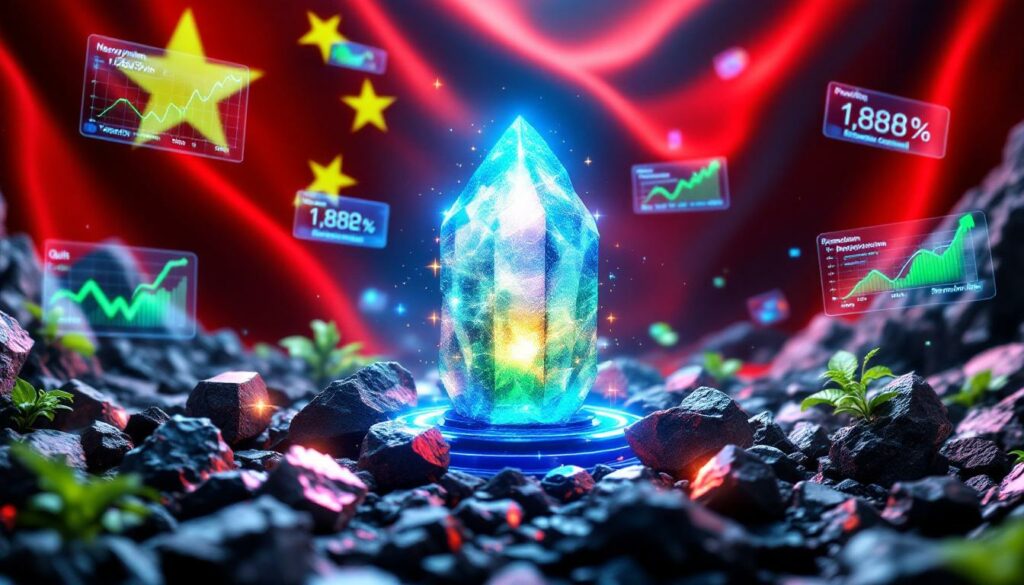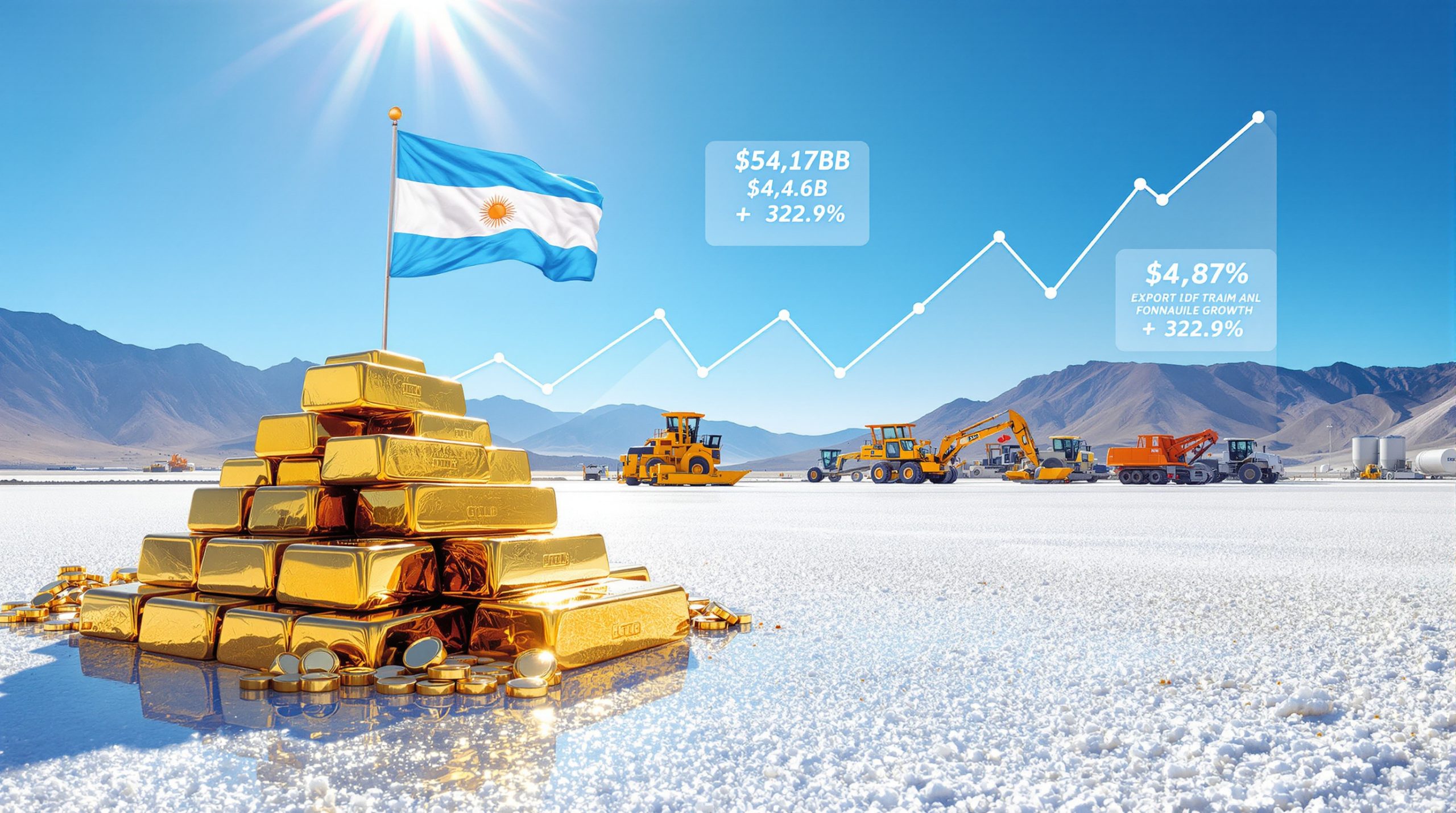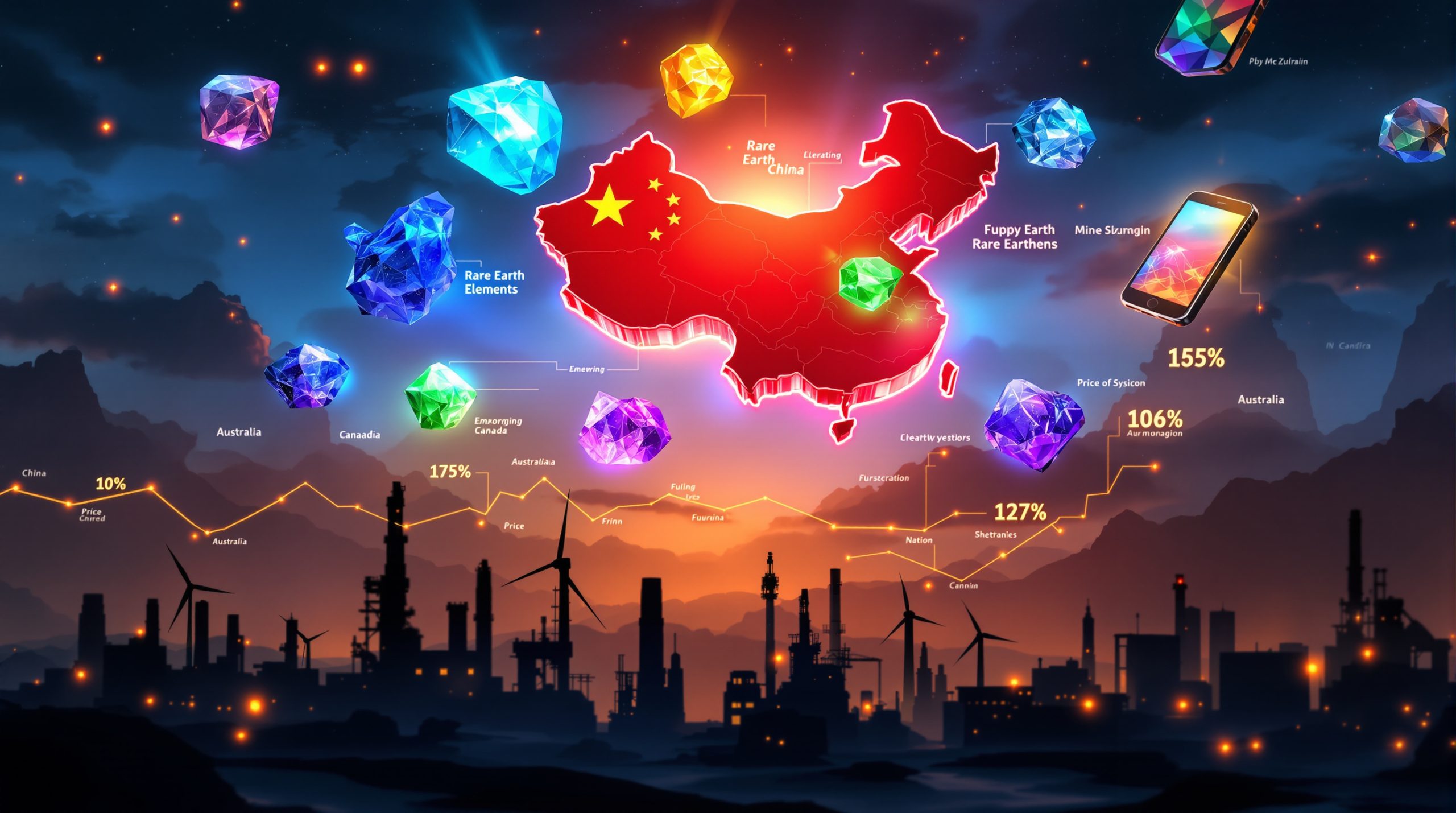China Northern Rare Earth's Explosive Growth Transforms Rare Earth Market
China Northern Rare Earth has stunned investors with an extraordinary performance forecast for the first half of 2025, triggering significant ripple effects across the rare earth permanent magnet sector. This remarkable development highlights the strategic importance of rare earth elements in global technology supply chains and signals potential shifts in market dynamics that investors should carefully monitor.
What is Driving China Northern Rare Earth's Exceptional Performance?
China Northern Rare Earth recently projected unprecedented results for the first half of 2025, with net profits expected to reach between 900-960 million yuan. This represents a staggering year-over-year increase of 1,882.54% to 2,014.71%. When excluding non-recurring items, the performance appears even more remarkable – the company's net profit is anticipated to reach 880-940 million yuan, reflecting an astonishing year-over-year growth of 5,538.33% to 5,922.76%.
This exceptional performance has already made significant waves in the market. On July 10, 2025, the rare earth permanent magnet concept index rose 2.04%, with several companies experiencing substantial gains:
- China Northern Rare Earth and Jingyuntong both reached their daily limit (10% increase)
- Jiuling Technology climbed 9.8%
- Zhongke Magnetic Industry, China Rare Earth, Ningbo Yunsheng, and Shenghe Resources all posted significant gains
Key Factors Behind the Surge
Several interconnected factors appear to be driving this exceptional performance:
- Sustained high rare earth prices throughout early 2025, particularly for praseodymium-neodymium oxide
- Export control measures implemented in April 2025, creating favorable domestic pricing dynamics
- Growing strategic value of rare earth permanent magnets in emerging technologies
- Operational efficiency improvements within China Northern Rare Earth's production processes
- Supply-side reforms limiting production capacity expansion
Industry analysts note that China Northern Rare Earth's dominant position in light rare earth processing has become increasingly valuable as global technology manufacturers compete for limited supplies. The company controls approximately 70% of China's light rare earth separation capacity, giving it significant pricing power in a constrained market.
"What we're seeing with China Northern Rare Earth is the culmination of years of strategic positioning combined with favorable market conditions," explains Dr. Liu Wei, rare earth industry consultant. "Their integration across the value chain from mining to processing gives them unparalleled advantages when prices rise."
How Have Rare Earth Prices Performed in 2025?
The rare earth market has experienced significant price fluctuations throughout the first half of 2025, with an overall upward trajectory that has directly benefited major producers like China Northern Rare Earth.
First Half Price Trends Analysis
Praseodymium-neodymium (Pr-Nd) oxide, a crucial component in manufacturing high-performance permanent magnets, saw its price increase by 11.68% in the first half of 2025. Starting from 398,000 yuan/mt on December 31, 2024, prices reached 444,500 yuan/mt by June 30, 2025.
The price movement wasn't linear, however, showing distinct patterns throughout the period:
- January 2025: Pre-Chinese New Year surge pushed prices to 415,000 yuan/mt (approximately 4.3% higher than the New Year's Day period)
- Late February: Slight pullback as new orders from magnetic material enterprises fell below expectations
- March: Rangebound trading in a relatively narrow band
- April: Initially experienced rapid price declines before rebounding due to major customer restocking
- May: Continued the upward trend amid various supporting factors
- June: Prices stabilized in a supply-demand stalemate
Recent Price Movements and Market Dynamics
On July 10, 2025, Pr-Nd oxide prices experienced a slight pullback, with the average price decreasing by 500 yuan/mt to 453,500 yuan/mt (a 0.11% decline). This minor correction followed a period of continuous price increases from July 3-8, driven by:
- Procurement activities by major rare earth enterprises
- Market concerns about potential oxide production cuts
- Growing expectations for demand recovery at month-end
However, the price stabilization occurred because:
- Metal plants faced severe losses due to high raw material costs
- Market acceptance for high-priced oxides remained limited
- Collective restocking by magnetic material enterprises had concluded
The pricing patterns reflect the complex interplay between supply quotas, production costs, demand cycles, and speculative trading. Notably, the supply side remains tightly controlled through China's rare earth production and processing quotas, creating persistent upward pressure on prices when demand is stable or growing.
What's Happening with China's Rare Earth Export Controls?
On April 4, 2025, China implemented export controls on medium-heavy rare earths, significantly impacting global supply chains and creating price disparities between domestic and international markets. This regulatory shift has been a key factor in China Northern Rare Earth's exceptional performance.
Current Status of Export Licenses
After initial uncertainty, several companies have reported obtaining rare earth export licenses:
- JL MAG Rare-Earth has secured licenses covering exports to the US, Europe, and Southeast Asia
- Earth-Panda reported that export business accounted for 31.98% of Q1 revenue, with US exports representing 10.61%
- Zhenghai Magnetic Material was among the early recipients of export licenses
- Xiamen Tungsten has obtained licenses and commenced exports
- Shenghe Resources confirmed approvals for certain products
The process has been described as "steady but deliberate," with authorities reviewing applications on a case-by-case basis. Companies report maintaining close communication with regulatory bodies to ensure compliance with the new export control framework.
Ministry of Commerce Position
On June 26, 2025, MOFCOM spokesperson He Yadong clarified China's approach to rare earth export controls during a press conference:
"China has approved a number of compliant applications and will continue strengthening the approval process for compliant applications. China is willing to enhance export control dialogues with relevant countries to promote convenient and compliant trade."
He emphasized that China "attaches great importance to maintaining global industrial and supply chain stability" while implementing necessary controls on strategic materials.
Impact on International Markets
The implementation of export controls triggered significant effects in global markets:
- Created initial panic in overseas supply chains, particularly for manufacturers dependent on dysprosium and terbium
- Caused European prices for these elements to surge dramatically
- Generated price spreads between domestic and overseas markets exceeding threefold
- Led to gradual export resumption as magnetic material enterprises obtained licenses
- Prompted mild price increases for Pr-Nd oxide in anticipation of supply constraints
The export controls represent part of China's broader strategy to maintain its dominant position in the rare earth value chain while ensuring domestic manufacturers have preferential access to these critical materials. The controls particularly focus on medium-heavy rare earths (dysprosium, terbium) essential for high-performance magnets used in defense applications and advanced technologies.
What Do Financial Institutions Forecast for the Rare Earth Sector?
Major securities firms have issued varied but generally optimistic outlooks for the rare earth sector, focusing on supply constraints, growing demand, and structural advantages for certain segments of the value chain.
Investment Outlook from Major Securities Firms
GF Securities
- Anticipates stricter management of China's rare earth mining quotas amid ongoing tariffs impact analysis
- Expects continued growth in the strategic value of rare earth permanent magnets
- Believes China Northern Rare Earth is well-positioned to benefit from light rare earth demand growth
Guotai Haitong Securities
- Identifies the sector as being in the second of three typical growth stages (initial growth → rapid expansion → maturity)
- Forecasts continued price increases driven by overseas restocking demand and domestic NEV peak season
- Predicts a concurrent increase in commodity prices and stock prices for the sector
- Recommends focusing on leading enterprises in resources and magnetic materials
- Notes that companies with established export channels will gain competitive advantages
Guotou Securities
- Projects slowing growth rate of supply quotas in 2025 compared to previous years
- Anticipates a demand gap in the global Pr-Nd oxide market that will support higher prices
- Expects continued price rises for Pr-Nd due to structural supply limitations
- Predicts narrowing price spreads between domestic and overseas medium-heavy rare earths as exports resume
- Remains optimistic about price increases for domestic dysprosium oxide and terbium oxide
Oriental Securities
- Highlights the scarcity of quotas benefiting upstream smelting and processing enterprises
- Anticipates these enterprises will dominate profit distribution in the industry chain
- Expects high-quality development with controllable product quantities, mild price increases, and steady profit growth
- Recommends attention to leading global rare earth industry chain groups with vertically integrated operations
The consensus among analysts points to a period of sustained strength for companies like China Northern Rare Earth that have dominant positions in the upstream segments of the value chain, with quotas and export controls creating favorable conditions for pricing power.
What Are the Growth Drivers for Rare Earth Demand?
The exceptional performance of China Northern Rare Earth is underpinned by robust demand growth from multiple application areas, creating a favorable supply-demand balance that supports higher prices and margins.
Emerging Applications Expanding Market Potential
The rare earth sector is experiencing demand growth from several established and emerging sources:
- New energy vehicles (NEVs) continue to drive significant demand, with China's NEV production growing at double-digit rates in 2025
- Wind power installations are expanding globally, with each direct-drive turbine requiring hundreds of kilograms of NdFeB magnets
- Home appliance markets maintain steady demand for energy-efficient motors using rare earth magnets
- Humanoid robots are emerging as a significant new application area with substantial growth potential
Particularly noteworthy is the development in robotics applications. JL MAG Rare-Earth disclosed that they are "collaborating with world-renowned tech companies on robot motor rotors," with small-batch deliveries already underway. Industry experts project that humanoid robots could become a major growth driver for high-performance magnets in the coming years.
Strategic Importance in Global Supply Chains
Beyond commercial applications, rare earth materials have gained heightened strategic significance in global technology competition:
- China Rare Earth Group is emphasizing green development throughout production processes
- The industry is increasingly focused on establishing comprehensive resource recycling systems
- R&D for rare earth functional materials is accelerating, with applications beyond permanent magnets
- Companies like Xiangming Smart are incorporating rare earth materials into high-efficiency motors for industrial applications
- Multiple enterprises maintain close communication with authorities to ensure compliant operations while meeting global demand
The diversification of applications, combined with limited supply growth due to environmental constraints and quota systems, creates a structural advantage for well-positioned companies like China Northern Rare Earth.
How Are Companies Adapting to the Changing Rare Earth Landscape?
In response to the evolving market conditions, companies across the rare earth value chain are implementing strategic adjustments to navigate challenges and capitalize on opportunities.
Supply Chain Management Strategies
Companies are taking proactive measures to ensure material availability and compliance with regulations:
- Earth-Panda maintains approximately two months of raw material inventory to buffer against supply disruptions
- Multiple companies have established stable cooperation with major suppliers like China Northern Rare Earth
- Diversification of supply channels has become a priority to reduce dependency on single sources
- Strict compliance systems have been implemented for export declarations
- Active engagement with regulatory authorities helps companies track policy changes and ensure adherence
The experience of Zhenghai Magnetic Material is illustrative. The company reported that it is "actively advancing export declarations" while "maintaining communication with authorities" to navigate the new export control framework efficiently. This approach allows them to continue serving international customers while operating within regulatory boundaries.
Environmental and Sustainability Initiatives
China Rare Earth Group has outlined comprehensive sustainability efforts that signal the direction of the industry:
- Integration of green development concepts throughout the production process
- Strategic planning and reform processes with environmental preservation as a core focus
- Sustained efforts in green mining and ecological restoration in mining regions
- Energy conservation and process innovation to reduce environmental impact
- Advancement of carbon emission accounting across the entire rare earth industry chain
- Research on dual carbon pathways for long-term sustainability in the sector
These initiatives reflect the industry's recognition that future growth depends on addressing environmental concerns while meeting growing demand. Companies that successfully balance these imperatives are likely to gain regulatory approval for expansion and secure preferential access to resources.
"The rare earth industry is entering a new phase where environmental stewardship and resource efficiency are not just regulatory requirements but competitive advantages," notes Professor Zhang Min, environmental policy researcher at Beijing University. "Companies that master green technologies will ultimately secure the most favorable positions in the industry."
What Should Investors Watch in the Rare Earth Market?
Investors looking to capitalize on developments in the rare earth sector should monitor several critical indicators that will influence market dynamics and company performances.
Key Market Indicators to Monitor
-
Supply quota announcements and implementation
- China's rare earth mining and processing quotas set the baseline for global supply
- Any changes to quota allocation methodology could reshape competitive dynamics
-
Price spreads between domestic and international markets
- Widening spreads indicate export control effectiveness
- Narrowing spreads may signal increased export license approvals
-
Export license approvals and their impact
- Track which companies are securing approvals and for which products
- Monitor the volume of permitted exports relative to pre-control periods
-
Demand trends in key application areas
- NEV production and sales figures, particularly in China and Europe
- Wind power installation forecasts and actual deployment rates
- Development pace in robotics and other emerging applications
-
Company-specific metrics
- Inventory levels and purchasing patterns
- Margin trends as indicators of pricing power
- Export performance for companies with international exposure
-
Policy developments
- Environmental regulations affecting mining and processing
- International trade measures targeting rare earth supply chains
- Critical minerals executive order initiatives related to minerals security
Investment Considerations
Based on analyst perspectives and current market conditions, investors might consider several approaches:
- Focus on companies with strong resource positions that benefit directly from quota limitations
- Consider leaders in magnetic materials production with established technological advantages
- Monitor firms with established export channels and licenses that can capture international price premiums
- Evaluate companies positioned to benefit from emerging applications such as robotics
- Assess enterprises with advanced mine reclamation innovations likely to gain favorable regulatory treatment
The rare earth market remains complex and influenced by both commercial and geopolitical factors. Successful investment strategies will likely depend on understanding the interplay between supply constraints, technological demand growth, and policy interventions.
FAQ: China Northern Rare Earth and Rare Earth Permanent Magnets
What caused China Northern Rare Earth's exceptional H1 2025 performance?
China Northern Rare Earth's performance surge of over 1,880% year-over-year appears to be driven by a combination of factors including sustained high rare earth prices, strategic positioning in the supply chain, effective cost management, and the beneficial impacts from export control measures that have created favorable pricing dynamics for domestic producers. The company's dominant position in light rare earth processing (controlling approximately 70% of China's separation capacity) gives it significant pricing power in a constrained market.
How have export controls affected the rare earth market?
Export controls implemented on April 4, 2025, created significant price disparities between domestic and international markets, with overseas prices for elements like dysprosium and terbium surging to more than three times their domestic equivalents. While exports have gradually resumed as companies obtain licenses, the controls have fundamentally altered global supply dynamics and reinforced China's strategic leverage in rare earth supply chains. Companies with approved export licenses have gained competitive advantages, while downstream manufacturers outside China have faced higher costs and supply uncertainties.
Which downstream industries are driving rare earth demand?
Key demand drivers include new energy vehicles (NEVs), wind power generation, high-efficiency motors, consumer electronics, and emerging applications such as humanoid robots. The NEV sector remains particularly important, with each vehicle requiring approximately 1-2 kg of NdFeB magnets. Wind turbines represent another major demand source, with direct-drive systems requiring several hundred kilograms of magnets per turbine. The robotics sector is emerging as an important application area for high-performance NdFeB magnets, with companies like JL MAG already supplying small-batch orders to "world-renowned tech companies."
What is the outlook for rare earth prices in the second half of 2025?
Analysts generally expect continued strength in rare earth prices, particularly for Pr-Nd oxide, where structural supply limitations are creating persistent upward pressure. The price spread between domestic and overseas medium-heavy rare earths is expected to narrow as exports resume under the licensing system, while domestic prices for dysprosium oxide and terbium oxide are projected to increase due to tight supply and growing demand from high-performance magnet applications. Guotou Securities specifically anticipates "a demand gap in the global Pr-Nd oxide market" that will support higher prices throughout 2025.
How are companies ensuring rare earth supply security?
Companies are implementing multi-channel supply strategies, maintaining higher inventory levels (typically around two months of stock), establishing stable cooperation with major suppliers like China Northern Rare Earth, and closely monitoring regulatory developments to ensure compliance with export controls and other requirements. Earth-Panda specifically reported maintaining "approximately two months of raw material
Want to Catch the Next Major Mineral Discovery Before the Market?
Discovery Alert's proprietary Discovery IQ model delivers instant notifications when significant ASX mineral discoveries are announced, providing actionable insights before the broader market reacts. Explore how historic discoveries have generated exceptional returns by visiting our dedicated discoveries page.




